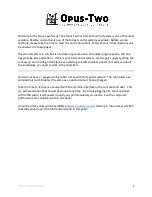
Maintenance—492/492P Service Vol. 1 (SN B030000 & up)
PREVENTIVE MAINTENANCE
Preventive maintenance consists of cleaning, visual in
spection, performance check, and if needed, a recalibration.
The preventive maintenance schedule that is established for
the instrument should be based on the environment in which
the instrument is operated and the amount of use. Under
average conditons (laboratory situation) a preventive main
tenance check should be performed every
1 0 0 0
hours of
instrument operation.
Do not allow water to get inside any enclosed assem
bly or .components such as the hybrid assemblies, RF
Attenuator assembly, potentiometers, etc. Instruc
tions for removing these assemblies are provided in
the Corrective Maintenance section. Do not clean any
plastic materials with organic cleaning solvents such
as benzene, toluene, xylene, acetone or similar com
pounds because they may damage the plastic.
Elapsed Time Meter
A 5000 hour elapsed time indicator, graduated in 500
hour increments is installed on the Z-Axis/RF Interface cir
cuit board. This provides a convenient way to check operat
ing time. The meter on new instruments may indicate from
200 to 300 hours elapsed time. Most instruments go
through a factory burn-in time to improve reliability. This is
similar to using aged components to improve reliability and
operating stability.
Lubrication
Components in this instrument do not require lubrication.
Service Fixtures and Tools for Maintenance
The following kits and fixtures are available to aid in ser
vicing the 492/492P:
Cleaning
Clean the instrument often enough to prevent dust or dirt
from accumulating in or on it. Dirt acts as a thermal insulat
ing blanket and prevents efficient heat dissipation. It also
provides high resistance electrical leakage paths between
conductors or components in a humid environment.
Exterior.
Clean the dust from the outside of the instru
ment by wiping or brushing the surface with a soft cloth or
small brush. The brush will remove dust from around the
front-panel selector buttons. Hardened dirt may be removed
with a cloth dampened in water that contains a mild deter
gent. Abrasive cleaners should not be used.
Interior.
Clean the interior by loosening accumulated
dust with a dry soft brush, then remove the loosened dirt
with low pressure air to blow the dust clear. (High velocity
air can damage some components.) Hardened dirt or grease
may be removed with a cotton tipped applicator dampened
with a solution of mild detergent in water. Do not leave de
tergent on critical memory components. Abrasive cleaners
should not be used. If the circuit board assemblies need
cleaning, remove the circuit board by referring to the instruc
tions under Corrective Maintenance in this section.
After cleaning, allow the interior to thoroughly dry before
applying power to the instrument.
Nomenclature
Service Kit; consisting of:
1 Front panel extender
1 Power module extender
1 Accessories Interface
extender
1 Ribbon cable
3 Coaxial cables,
Sealectro male-to-Sealectro
female
1 VR module handle
1 Circuit board extender
assembly kit:
consisting of:
1 Left extender board
2 Right extender boards
1 Frame (extrusion for
circuit board extender)
6
Screws, panhead with
flat and lockwashers
Tektronix Part No.
006-3286-00
067-0973-00
067-0971-00
067-0972-00
175-2901-00
175-2902-00
367-0285-00
672-0865-00
670-5562-00
670-5563-00
426-1527-00
211-0116-00
In addition to the above, the following tools are
recommended:
Screwdriver, flat, with 1/4 to 3/8-inch bit.
Screwdriver, Posidrive® 440-2.
Wrench, 5/16-inch open end (used to remove or replace
semi-rigid coaxial cable connectors).
Hex drive wrenches, 3/32, 5/64, 7/64-inch (used to re
move hex screws that hold module assemblies and their
covers in place).
4-2
REV AUG 1981
















































